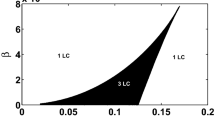Abstract
In this paper perturbation methods are used for the mathematical analysis of coupled relaxation oscillators. This study covers entrainment by an external periodic stimulus as well as mutual entrainment of coupled oscillators with different limit cycles. The oscillators are of a type one meets in the modeling of biological oscillators by chemical reactions and electronic circuits. Special attention is given to entrainment different from 1∶1. The results relate to phenomena occurring in physiological experiments, such as the periodic stimulation of neural and cardiac cells, and in the non-regular functioning of organs and organisms, such as the AV-block in the heart.
Similar content being viewed by others
Literature
Allen, T. 1983. “On the Arithmetic of Phase Locking: Coupled Neurons as a Lattice on R2.”Physica 6D, 305–320.
Auchmuty, J. F. G. and G. Nicolis, 1976. “Bifurcation Analysis of Reaction Diffusion Equations—III. Chemical Oscillations.”Bull. math. Biol. 38, 325–350.
Cohen, A. H., P. J. Holmes and R. H. Rand. 1982. “The Nature of the Coupling between Segmental Oscillators of the Lamprey Spinal Generator for Locomotion: a Mathematical Model.”J. math. Biol. 13, 345–369.
Ermentrout, G. B. 1981. “n:m Phase-locking of Weakly Coupled Oscillators.”J. math. Biol. 12, 327–342.
— and N. Kopell. 1983. “Frequency Plateaus in a Chain of Weakly Coupled Oscillators I and II.” Boston, MA: Department of Mathematics, Northeastern University, preprints.
Gear Luce, C. 1971.Biological Rhythms in Human and Animal Physiology. New York: Dover.
Glass, L. and M. C. Mackey. 1979. “A Simple Model for Phase Locking of Biological Oscillators.”J. math. Biol. 7, 339–352.
— and R. Perez. 1982. “Fine Structure of Phase Locking.”Phys. Rev. Lett. 48, 1772–1775.
Gollub, J. P., T. O. Brunner and B. C. Danly. 1978. “Periodicity and Chaos in Coupled Nonlinear Oscillators.”Science 200, 48–50.
Grasman, J. and M. J. W. Jansen. 1979. “Mutually Synchronized Relaxation Oscillators as Prototypes of Oscillating Systems in Biology.”J. math. Biol. 7, 171–197.
Guckenheimer, J. 1980. “Symbolic Dynamics and Relaxation Oscillations.”Physica 1D, 227–235.
Guevara, M. R., L. Glass and A. Shrier. 1981. “Phase Locking, Period-doubling Bifurcations and Irregular Dynamics in Periodically Stimulated Cardiac Cells.”Science 214, 1350–1353.
Holden, A. V. 1976. “The Response of Excitable Membrane Models to a Cyclic Input.”Biol. Cybernet. 21, 1–7.
Hoppensteadt, F. C. 1981. “Electric Models of Neurons.”Lect. appl. Math. 19, 327–344.
Keener, J. P. 1981. “On Cardiac Arrythmias: AV Conduction Block.”J. math. Biol. 12, 215–225.
Kreifeldt, J. 1970. “Ensemble Entrainment of Self-sustaining Oscillators: a Possible Application to Neural Signals.”Math. Biosci. 8, 425–436.
Kuramoto, Y. 1975. “Self Entrainment of a Population of Coupled Nonlinear Oscillators.” InLecture Notes in Physics, No. 39.International Symposium on Mathematical Problems in Theoretical Physics, Ed. H. Araki, pp. 420–422. Berlin: Springer.
Lopes da Silva, F. H., A. van Rotterdam, P. Barts, E. van Heusden and W. Burr. 1976. “Models of Neuronal Populations: the Basic Mechanisms of Rhythmicity.” InProgress in Brain Research, Ed. D. Swaab and M. E. Corner, Vol. 45, pp. 281–308. Amsterdam: Biomedical Press.
Mishenko, E. F. and N. Kh. Rosov. 1980.Differential Equations with Small Parameters and Relaxation Oscillations. New York: Plenum Press.
Neu, J. C. 1980. “Large Populations of Coupled Chemical Oscillators.”SIAM J. appl. Math. 38, 305–316.
Petrillo, G. A., L. Glass and T. Trippenbach. 1983. “Phase Locking of the Respiratory Rhythm in Cats to a Mechanical Ventilator.”Can. J. Physiol. Pharmacol. 61, 599–607.
Sarna, S. K., E. E. Daniel and Y. J. Kingma. 1972. “Simulation of the Electric-control Activity of the Stomach by an Array of Oscillators.”Digest. Dis. 17, 299–310.
Stoker, J. J. 1950.Nonlinear Vibrations. New York: Interscience.
Torre, V. 1975. “Synchronization on Nonlinear Biochemical Oscillators Coupled by Diffusion.”Biol. Cybernet. 17, 137–144.
Tyson, J. J. 1976.Lecture Notes in Biomathematics, Vol. 10. The Belousov-Zhabotinskii Reaction. Berlin: Springer.
Van der Pol, B. and J. Van der Mark. 1928. “The Heart Beat Considered as a Relaxation Oscillation and an Electrical model of the Heart.”Phil. Mag. 4, 763–773.
Van Meerwijk, W. P. M., G. de Bruin, A. C. G. van Ginneken, J. van Hartevelt, H. J. Jongsma, S. S. Scott and D. L. Ypey. 1983. “Phase Resetting Properties of Cardiac Pacemaker Cells.” Amsterdam: Department of Physiology, University of Amsterdam, preprint.
Wever, R. A. 1979.The Circadian System of Man. New York: Springer.
Wiener, N. 1958.Nonlinear Problems in Random Theory. Cambridge, MA: MIT Press.
Winfree, A. T. 1980. “The Geometry of Biological Time.”Biomathematics Vol. 8. Berlin, Springer.
—. 1983. “Sudden Cardiac Death: a Problem in Topology.”Sci. Am. 248, 118–131.
Yoshizawa, S., H. Osada and J. Nagumo. 1982. “Pulse Sequences Generated by a Degenerate Analog Neuron Model.”Biol. Cybernet. 45, 23–34.
Ypey, D. L., W. P. M. van Meerdijk, E. Ince and G. Groos. 1980. “Mutual Entrainment of Two Pacemaker Cells. A Study with an Electronic Parallel Conductance Model.”J. theor. Biol. 86, 731–755.
——, and G. de Bruin. 1982. “Suppression of Pacemaker Activity by Rapid Repetitive Phase Delay.”Biol. Cybernet. 45, 187–194.
Author information
Authors and Affiliations
Rights and permissions
About this article
Cite this article
Grasman, J. The mathematical modeling of entrained biological oscillators. Bltn Mathcal Biology 46, 407–422 (1984). https://doi.org/10.1007/BF02462016
Received:
Revised:
Issue Date:
DOI: https://doi.org/10.1007/BF02462016




